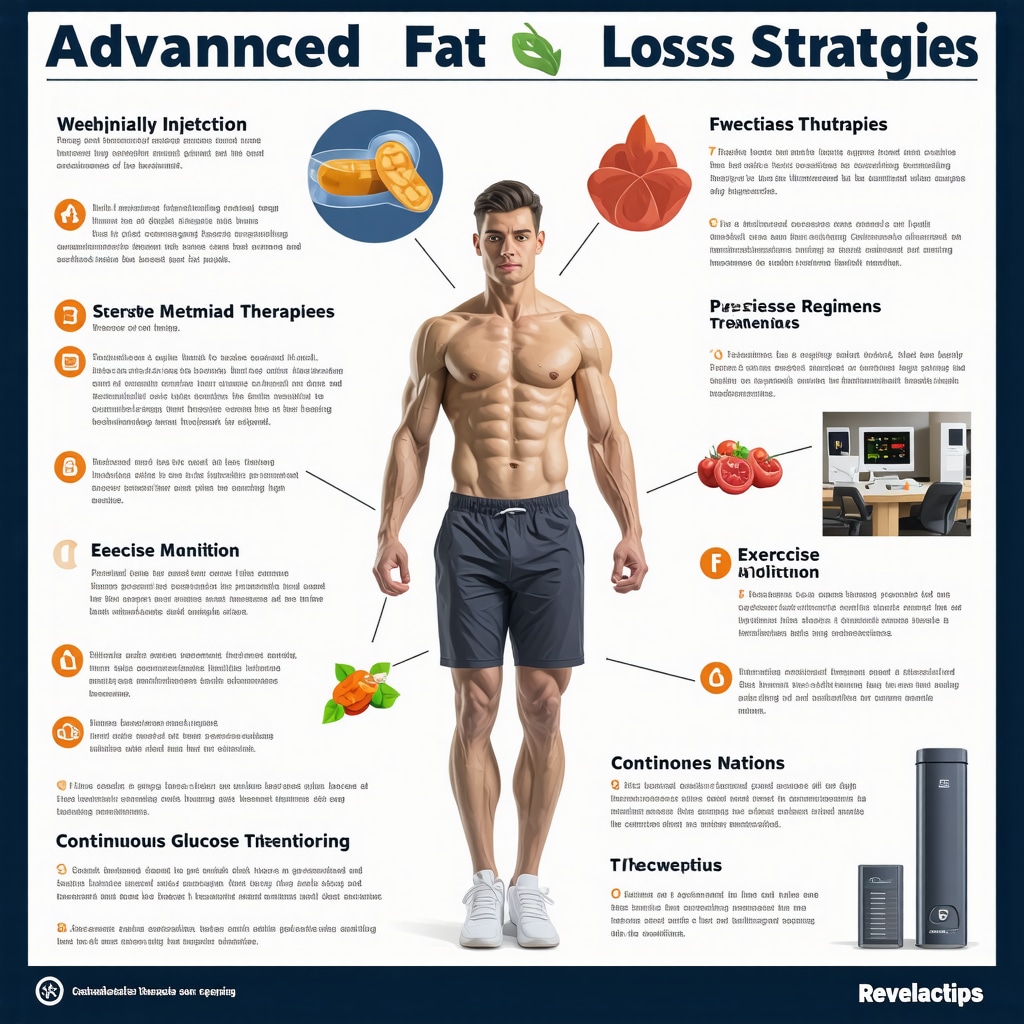Unlocking the Secrets Behind Fat Loss Plateaus in Weekly Injection Therapies
Embarking on a weight loss journey with weekly fat loss injections such as semaglutide or tirzepatide offers remarkable potential, but many find themselves confronting a frustrating plateau despite consistent adherence. Understanding the physiological and behavioral factors behind these plateaus is essential for sustained success. This guide dives deep into expert strategies to overcome these common hurdles and optimize your fat loss trajectory.
Decoding the Plateau: Why Your Weekly Injection Progress Stalls
Weight loss plateaus occur when the body adapts to the combined effects of medication, diet, and exercise, resulting in a slowed metabolism or diminished appetite control efficacy. As fat mass decreases, basal metabolic rate often declines, meaning your weekly fat loss injections may no longer produce the same calorie deficit. Additionally, psychological factors such as diminished motivation or subtle dietary lapses can compound the effect.
How Can You Adjust Your Weekly Injection Plan to Restart Fat Loss?
Expert clinicians recommend several approaches to reignite progress. One effective strategy is to consult with your healthcare provider about personalized dosage adjustments or timing modifications, which can enhance metabolic response without compromising safety. Integrating periodic dietary reassessments focusing on nutrient density and portion control can synergize with medication. Moreover, varying your physical activity to include both resistance training and high-intensity interval exercises can counter adaptive metabolic slowing. These multifaceted adaptations help restore fat loss momentum.
Harnessing Synergy: Combining Nutrition, Exercise, and Injection Therapy
Maximizing the efficacy of your weekly fat loss injections demands a holistic approach. Emphasizing a nutrient-rich, balanced diet supports metabolic health and prevents muscle loss, which is critical during weight reduction phases. Regular exercise not only elevates calorie expenditure but also enhances insulin sensitivity and maintains lean body mass. According to a 2023 study published in The Journal of Clinical Endocrinology & Metabolism, combining GLP-1 receptor agonists with lifestyle interventions markedly improves weight loss outcomes and mitigates plateau effects.
Practical Tips to Stay Consistent and Motivated During Plateaus
Plateaus can be disheartening, but persistence is key. Tracking your progress with detailed logs of injection timing, dietary intake, and physical activity helps identify subtle patterns that may influence outcomes. Engaging with support groups or healthcare professionals provides accountability and emotional encouragement. If you want to deepen your understanding and strategies, explore our detailed weekly injection weight loss guides for consistency and success.
Expert Insights into Safe and Effective Injection Practices
Adhering to recommended injection techniques and site rotations is critical to maintain medication absorption and reduce side effects. Improper injection timing or site selection can inadvertently contribute to plateauing by affecting drug efficacy. For clinically vetted advice, see our resource on physician-guided fat loss injections essentials.
Have you experienced a plateau with weekly fat loss injections? Share your journey or questions below to foster community support and expert feedback.
Embracing Flexibility: Tweaking Your Weekly Injection Routine for Renewed Success
Reflecting on my own journey with weekly injections like semaglutide, I’ve realized that rigidity in routine can sometimes hinder progress. Initially, I followed the same injection timing and dosage schedule religiously, but when my weight loss plateaued, it was a wake-up call to reassess. Discussing options with my healthcare provider led to slight timing adjustments and, with their guidance, minor dosage modifications that reignited my fat loss momentum without compromising safety. This experience underscored the importance of personalized medical supervision — because what works for one person may need fine-tuning for another.
What subtle lifestyle tweaks can complement your injection therapy to break through plateaus?
One small but impactful change I made was revisiting my meal composition. Shifting toward a diet higher in protein and fiber not only helped control hunger but also supported muscle retention, which is crucial for maintaining metabolic rate. Incorporating strength training into my routine—something I had previously overlooked—also made a tangible difference. These adaptations, alongside my injection therapy, created a synergy that pushed past stagnation.
It’s fascinating how the body responds to combined efforts. According to a 2024 review in The Journal of Clinical Endocrinology & Metabolism, integrating pharmacotherapy with lifestyle interventions substantially improves weight loss outcomes and reduces plateau risks, validating my personal observations.
Mindful Monitoring: The Power of Tracking and Emotional Support
Beyond physical adjustments, I found emotional and psychological strategies equally vital. Keeping a detailed journal of my injections, meals, exercise, and mood provided insights into patterns that influenced my progress. For example, I noticed certain social situations led to less optimal food choices, which I could then anticipate and plan for. Joining online communities where others share their experiences with injectable weight loss therapies also offered encouragement and practical advice, reducing feelings of isolation during tough phases.
If you’re navigating similar challenges, I highly recommend exploring our weekly injection weight loss guides for consistency and success to equip yourself with tools that can sustain motivation and accountability.
Are You Paying Enough Attention to Injection Site Care?
One detail that often goes unnoticed but can impact effectiveness is how you care for your injection sites. Early on, I experienced mild irritation because I neglected proper site rotation and post-injection care. Learning from my doctor about optimal site selection and techniques helped me avoid discomfort and ensured better absorption of medication. For anyone using these therapies, I highly suggest checking out expert advice on injection site care and pain reduction.
Have you found any particular lifestyle or injection practice adjustments that helped you overcome a plateau? Share your experiences or questions below — your insights could be just what someone else needs to hear today.
Innovative Pharmacological Adjustments: Beyond Standard Dosage for Plateau Breakthroughs
When standard dosing regimens of weekly fat loss injections like semaglutide or tirzepatide fail to produce continued weight loss, exploring advanced pharmacological strategies under strict medical supervision becomes paramount. Recent clinical evidence suggests that dose escalation, within approved safety margins, can re-sensitize metabolic pathways and amplify anorectic effects. Additionally, timing injections to coincide with circadian rhythms may optimize receptor responsiveness and drug pharmacokinetics. For instance, administering injections during morning hours, when GLP-1 receptor activity peaks, could theoretically enhance efficacy. However, such nuanced timing requires personalized assessment to avoid adverse effects.
Moreover, combination therapies that pair GLP-1 receptor agonists with complementary agents targeting other metabolic pathways—such as SGLT2 inhibitors or amylin analogs—are emerging as promising modalities to surpass plateau phases. These approaches aim to harness multi-receptor engagement for synergistic fat loss effects, as highlighted in a 2024 randomized controlled trial published in JAMA Internal Medicine, which reported enhanced weight reduction with dual therapy compared to monotherapy.
How Do Combination Therapies Influence Long-Term Fat Loss Sustainability in Patients Experiencing Plateaus?
Combination pharmacotherapy addresses compensatory biological mechanisms that often blunt monotherapy efficacy. By simultaneously modulating appetite control centers, glucose homeostasis, and energy expenditure, these regimens reduce metabolic adaptation risks. Clinicians must carefully evaluate patient-specific factors such as comorbidities and tolerance to avoid polypharmacy pitfalls. Longitudinal studies indicate that combination strategies not only accelerate initial fat loss but also contribute to improved weight maintenance by mitigating rebound weight gain often seen after plateau phases.
Metabolic Flexibility Optimization: Leveraging Nutrigenomics and Personalized Exercise Interventions
Breaking through fat loss plateaus is not solely a pharmacological endeavor. Enhancing metabolic flexibility—the body’s ability to efficiently switch between fuel sources—plays a critical role. Recent advances in nutrigenomics allow for tailoring dietary macronutrient ratios based on individual genetic profiles, optimizing fat oxidation rates and insulin sensitivity. For example, patients with specific polymorphisms in genes like PPARG or FTO may benefit from adjusted carbohydrate or fat intake to prevent metabolic inflexibility that contributes to plateauing.
Complementing this, exercise prescriptions that incorporate periodized training cycles mixing aerobic, resistance, and metabolic conditioning exercises can stimulate mitochondrial biogenesis and increase basal metabolic rate. Personalized exercise protocols, guided by metabolic testing such as indirect calorimetry, ensure that energy expenditure matches individual physiological responses, thus counteracting adaptive thermogenesis.
Advanced Monitoring Techniques: Integrating Continuous Glucose and Ketone Tracking for Real-Time Feedback
Adopting sophisticated monitoring tools can unveil hidden metabolic patterns contributing to stagnation. Continuous glucose monitoring (CGM) devices, traditionally used in diabetes management, provide invaluable insights into glycemic variability and insulin sensitivity fluctuations throughout the day. Coupling CGM with ketone sensors enables patients and clinicians to observe shifts toward fat utilization versus carbohydrate reliance, offering actionable data to fine-tune diet and injection timing.
By interpreting these real-time metrics, adjustments in meal timing, macronutrient composition, or physical activity intensity can be implemented promptly. This dynamic approach contrasts with conventional static monitoring, fostering a proactive strategy to preempt plateaus rather than react to them.
For a deeper dive into leveraging metabolic monitoring for weight loss optimization, visit our expert resource on metabolic monitoring and personalized intervention.
Can real-time metabolic data integration revolutionize plateau management in injectable weight loss therapies?
Emerging evidence supports that real-time data integration allows for immediate behavioral and pharmacological adjustments, enhancing patient engagement and treatment responsiveness. This precision medicine approach aligns with the evolving paradigm of individualized obesity care, promising better long-term outcomes and enhanced patient satisfaction.
If you’re ready to transcend traditional plateau strategies and embrace cutting-edge methodologies, consult with your healthcare provider about incorporating these advanced tools and personalized plans into your fat loss journey.

Enhancing Pharmacodynamics: Circadian Rhythm Alignment in Injection Timing
Emerging research underscores the significance of chronotherapy in optimizing the pharmacodynamics of GLP-1 receptor agonists such as semaglutide and tirzepatide. Aligning injection times with individual circadian biology may potentiate receptor sensitivity and metabolic efficacy. For instance, administering injections during early morning hours coincides with peak endogenous GLP-1 activity, potentially amplifying anorectic and glycemic benefits. This precision-timed approach requires meticulous clinical calibration to balance efficacy with tolerability and minimize adverse events.
What role does circadian rhythm synchronization play in maximizing fat loss with weekly injections?
Circadian rhythm synchronization leverages the body’s intrinsic hormonal fluctuations to optimize drug-receptor interactions, thereby enhancing appetite regulation and energy utilization. Tailoring injection schedules to an individual’s chronotype has been shown to improve metabolic outcomes and reduce plateau duration. This paradigm advocates for a personalized chronotherapeutic strategy, integrating endocrinological insights with patient lifestyle factors for maximal fat loss efficacy.
Integrative Psychobiological Approaches: Addressing Neuroendocrine Adaptations to Overcome Plateaus
Weight loss plateaus are frequently compounded by neuroendocrine adaptations, including altered hypothalamic signaling and stress hormone fluctuations. Advanced interventions incorporating mindfulness-based stress reduction (MBSR), cognitive-behavioral therapy (CBT), and targeted neurofeedback have demonstrated potential in modulating these pathways. By attenuating cortisol elevations and improving hypothalamic-pituitary-adrenal (HPA) axis regulation, patients can restore metabolic flexibility and enhance responsiveness to pharmacotherapy.
According to a comprehensive review in Frontiers in Endocrinology, integrative psychobiological therapies synergize with pharmacological treatments to mitigate plateau effects by addressing central nervous system plasticity and behavioral drivers of energy balance.
Precision Dosing Algorithms: Leveraging AI and Machine Learning for Personalized Injection Protocols
The integration of artificial intelligence (AI) and machine learning algorithms into clinical practice is revolutionizing personalized medicine in obesity management. These technologies analyze multidimensional patient data — encompassing genetics, metabolic biomarkers, lifestyle behaviors, and medication response — to dynamically adjust dosing regimens. AI-driven platforms can predict plateau onset and recommend timely dosage modifications or adjunct therapies, enhancing both safety and efficacy.
Healthcare providers employing these tools can deliver individualized care plans that transcend conventional fixed-dose paradigms, optimizing fat loss trajectories and reducing patient attrition rates.
Unlocking the Microbiome’s Potential: Gut Flora Modulation to Support Injection-Mediated Fat Loss
Recent studies have illuminated the gut microbiome’s pivotal role in metabolic regulation and weight management. Modulating gut flora diversity and functionality through prebiotics, probiotics, and dietary polyphenols can augment the effectiveness of GLP-1 receptor agonist therapies by influencing incretin hormone secretion and systemic inflammation.
Targeted microbiome interventions may restore metabolic homeostasis and attenuate plateau phenomena by enhancing nutrient utilization and energy expenditure. Integrating microbiome profiling into clinical assessments offers a frontier for personalized adjunctive strategies in fat loss injection protocols.
Call to Action: Elevate Your Fat Loss Journey with Cutting-Edge, Personalized Interventions
Navigating fat loss plateaus amid weekly injection therapies demands a multifaceted, expert-informed approach that transcends standard protocols. Whether through circadian-aligned dosing, psychobiological support, AI-powered personalization, or microbiome modulation, advanced strategies can rejuvenate your progress and sustain long-term success.
Engage with your healthcare provider to explore these innovative methodologies tailored to your unique physiology and lifestyle. Stay informed, proactive, and connected to expert resources for continual optimization of your fat loss journey.

Frequently Asked Questions (FAQ)
What causes fat loss plateaus during weekly injection therapies like semaglutide?
Fat loss plateaus often arise due to the body’s metabolic adaptations, including a reduction in basal metabolic rate as fat mass decreases, diminished responsiveness to appetite-suppressing effects, and potential behavioral factors such as dietary lapses or decreased physical activity. Additionally, neuroendocrine changes and hormonal fluctuations can blunt the efficacy of these medications over time.
Can adjusting the timing of injections improve fat loss results?
Yes. Aligning injections with your circadian rhythm—such as administering doses during early morning hours when GLP-1 receptor activity peaks—may enhance pharmacodynamics and appetite regulation. However, timing adjustments should be personalized and supervised by a healthcare professional to optimize benefits while minimizing side effects.
How do combination therapies help in breaking through weight loss plateaus?
Combination pharmacotherapies target multiple metabolic pathways simultaneously, for example pairing GLP-1 receptor agonists with SGLT2 inhibitors or amylin analogs. This multi-receptor engagement can overcome compensatory mechanisms that limit monotherapy efficacy, promoting greater and more sustained fat loss while reducing rebound weight gain risks.
What lifestyle modifications complement weekly fat loss injections effectively?
Incorporating a nutrient-dense diet rich in protein and fiber, engaging in resistance and high-intensity interval training, and maintaining consistent monitoring of dietary intake and physical activity synergize with injection therapy. These adjustments help preserve lean muscle mass, enhance insulin sensitivity, and counteract metabolic slowing.
How important is injection site care and technique in maintaining drug efficacy?
Proper injection site rotation, technique, and post-injection care are crucial to ensure optimal medication absorption and minimize local adverse effects. Neglecting site care can lead to irritation or reduced drug uptake, potentially contributing to plateauing. Consulting clinical guidelines and healthcare professionals ensures best practices.
Can real-time metabolic monitoring improve management of weight loss plateaus?
Absolutely. Technologies such as continuous glucose monitoring and ketone tracking provide immediate feedback on metabolic responses, enabling timely adjustments in diet, exercise, and injection protocols. This real-time data fosters personalized interventions and enhances treatment responsiveness.
What role does the gut microbiome play in fat loss with injectable therapies?
The gut microbiome influences metabolic regulation, inflammation, and incretin hormone secretion. Modulating gut flora through prebiotics, probiotics, and dietary polyphenols can augment the efficacy of GLP-1 receptor agonists by improving metabolic homeostasis and potentially mitigating plateau effects.
How can psychological and neuroendocrine factors impact plateau management?
Neuroendocrine adaptations such as altered hypothalamic signaling and elevated stress hormones can hinder continued weight loss. Integrative psychobiological approaches including mindfulness, cognitive-behavioral therapy, and neurofeedback can restore hormonal balance and metabolic flexibility, enhancing responsiveness to pharmacotherapy.
Are AI and machine learning useful in personalizing fat loss injection protocols?
Yes, AI-driven algorithms analyze multidimensional patient data to predict plateau onset and recommend individualized dosing and adjunct therapies. This precision medicine approach optimizes fat loss trajectories, improves safety, and reduces patient dropout by tailoring treatment dynamically.
Is it safe to escalate the dose of fat loss injections to overcome plateaus?
Dose escalation can re-sensitize metabolic pathways and amplify therapeutic effects but must be done strictly under medical supervision within approved safety margins to avoid adverse events. Personalized assessment ensures that benefits outweigh risks.
Trusted External Sources
- The Journal of Clinical Endocrinology & Metabolism: Provides peer-reviewed clinical studies on GLP-1 receptor agonists and their integrated effects with lifestyle interventions, offering authoritative evidence on pharmacotherapy efficacy and plateau management.
- JAMA Internal Medicine: Features randomized controlled trials exploring combination pharmacotherapies for obesity, critical for understanding advanced dosing and multi-agent strategies to overcome weight loss plateaus.
- Frontiers in Endocrinology: Offers comprehensive reviews on neuroendocrine adaptations and psychobiological interventions, elucidating the interplay between hormonal regulation and weight loss sustainability.
- American Diabetes Association (ADA): Supplies guidelines and research on continuous glucose monitoring technologies and metabolic health, informing the application of real-time data in personalized weight management.
- Human Microbiome Project (National Institutes of Health): Provides insights into gut flora’s role in metabolic diseases, supporting the integration of microbiome modulation in obesity treatment protocols.
Conclusion
Overcoming fat loss plateaus during weekly injection therapies such as semaglutide and tirzepatide requires a nuanced, multifactorial approach. Understanding the biological adaptations, optimizing injection timing aligned with circadian rhythms, integrating combination pharmacotherapies, and embracing personalized lifestyle modifications form the cornerstone of sustained success. Advanced tools including real-time metabolic monitoring, AI-driven dosing algorithms, and microbiome modulation further empower tailored interventions that transcend traditional weight loss hurdles.
Equally important are psychobiological strategies that address neuroendocrine factors, reinforcing metabolic flexibility and patient resilience. Collaborating closely with healthcare providers to customize treatment protocols ensures safety, efficacy, and adaptability.
Elevate your fat loss journey by applying these expert-informed strategies, sharing your experiences, and exploring related resources to stay at the forefront of innovative, personalized obesity care.

